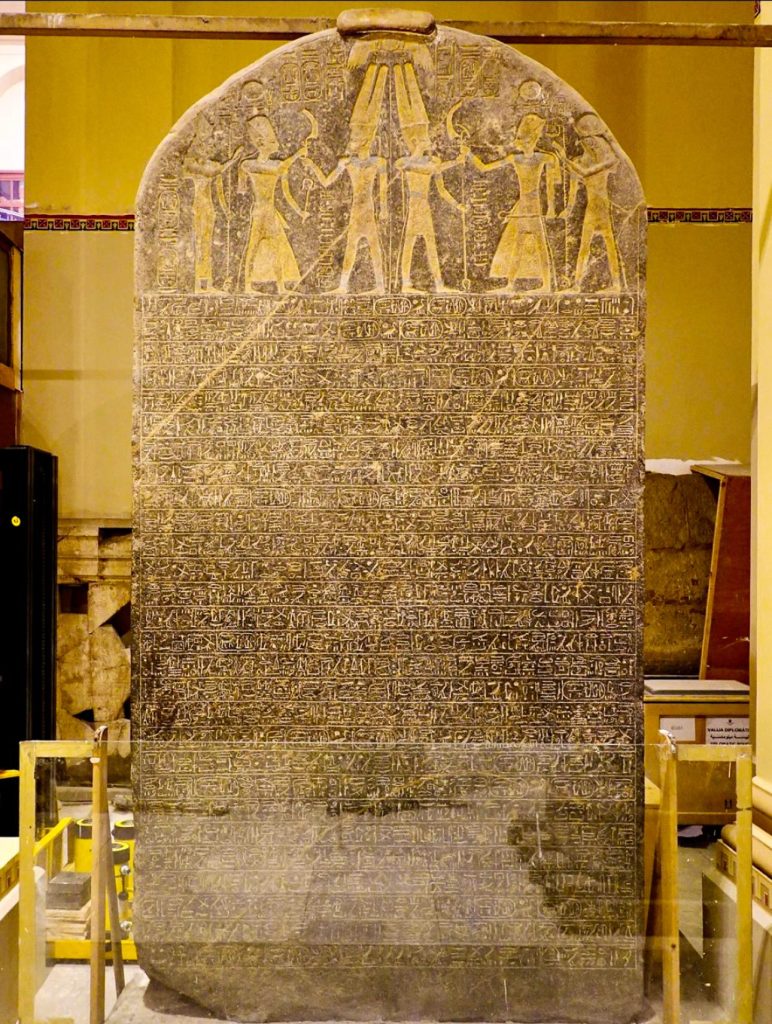In the vast chronicle of ancient history, few relics possess the profound impact and historical significance of the Merneptah Stele. Discovered in the late 19th century in Thebes, Egypt, this monumental slab of black granite dates back to the reign of Pharaoh Merneptah, who ruled Egypt from 1213 to 1203 BC. Standing over 10 feet tall and inscribed with hieroglyphs, the Merneptah Stele is not just a celebration of Egyptian victories—it is a window into a crucial period of human history. What truly elevates this artifact to extraordinary status is its mention of “Israel,” making it the earliest known reference to the people of Israel in any Egyptian or external text. This simple yet momentous line has had an enduring impact on the fields of archaeology, ancient Near Eastern studies, and biblical history.

Commissioned by Pharaoh Merneptah, the stele primarily serves to commemorate his successful military campaigns, especially against Libyan invaders and their allies. In a culture where kingship was closely tied to military prowess and divine favor, inscribing these victories in stone was a powerful propaganda tool. But while much of the text focuses on Egypt’s exploits in Africa and the Mediterranean, the portion of the inscription that captured global scholarly attention reads: “Israel is laid waste, his seed is not.” These nine words, etched over three thousand years ago, have sparked extensive debate, analysis, and reflection among historians and archaeologists.
The phrase itself may be brief, but its implications are far-reaching. It indicates that, by the late 13th century BC, a people identified as “Israel” had already established a recognizable presence in Canaan. This challenges the assumption that Israel’s identity developed only centuries later. While the stele presents this group as a defeated foe, the fact that Egypt saw fit to mention them at all underscores their emerging significance in the region. Egypt’s detailed recordkeeping was generally reserved for notable adversaries, suggesting that Israel—though not yet a fully centralized nation—was a societal entity of some consequence.
What makes the Merneptah Stele particularly valuable is its function as an extra-biblical source. Much of our understanding of ancient Israel derives from the Hebrew Bible, a religious text that blends history, theology, and oral tradition. While the Bible is invaluable in many respects, it has limitations as a historical document due to its spiritual and didactic purposes. The Merneptah Stele, on the other hand, offers a purely historical account from a contemporaneous civilization with no theological stake in Israel’s narrative. In doing so, it corroborates the notion that Israelites—or a group identified as such—were active in the region long before the biblical monarchy arose.
Moreover, the stele opens a broader conversation about the complex geopolitics of the ancient Near East. The late Bronze Age was a time of significant upheaval, with empires vying for control over key territories. Egypt, under the rule of Merneptah, was aggressively asserting its influence over Canaan, a strategic area that connected trade routes between Africa, Asia, and the Mediterranean. The reference to Israel amidst a long list of vanquished city-states and tribal groups paints a picture of a dynamic and competitive environment where emerging groups like the Israelites had to navigate powerful hegemonies.
Interestingly, while the stele speaks of Israel’s destruction, the very act of recording their defeat confirms their existence. Historical records of conquest often exaggerate victories, and it is unlikely that Merneptah’s forces truly annihilated an entire people. More plausibly, the reference suggests a punitive raid that temporarily disrupted Israelite communities. Nevertheless, the mention validates Israel’s presence and perhaps even its resilience. After all, the people of Israel would go on to form kingdoms, develop religious traditions, and leave behind their own rich cultural legacy.
Another layer of significance lies in the linguistic choices made in the inscription. In Egyptian hieroglyphs, determinatives were symbols used to indicate the nature of a word. For most conquered cities on the stele, the determinative for a foreign city is used. But for Israel, the determinative for a people is applied instead. This subtle yet meaningful distinction suggests that Israel was not a city-state but a loosely organized tribal or ethnic group, possibly semi-nomadic at the time. This supports the theory that early Israelite society emerged from a network of hill-dwelling clans in central Canaan rather than from a centralized urban culture.
The Merneptah Stele continues to captivate scholars for its historical, linguistic, and theological implications. It exemplifies how archaeological findings can complement, confirm, or challenge traditional narratives passed down through generations. Each detail—be it the phrasing, location, or context—adds another layer to our understanding of the ancient world. The stele does not answer all our questions about early Israel, but it provides a rare and invaluable glimpse into a formative period.
To this day, the Merneptah Stele stands as a silent testament to a world of kingdoms, tribes, and conquests—a world in which identity, survival, and legacy were written in stone. For archaeologists, it serves as a reminder of how a single artifact can reshape entire fields of study. For history enthusiasts, it offers a tangible connection to people and places long vanished but still deeply relevant. And for those curious about the roots of civilization and faith, it underscores the importance of looking beyond texts and into the earth itself for answers.
Thus, the Merneptah Stele is far more than a stone slab adorned with ancient hieroglyphs. It is a bridge between past and present, fact and faith, conquest and continuity. It speaks to the enduring human need to record, remember, and understand. In its carved words, we find not only a record of destruction but also a spark of historical truth that continues to enlighten us thousands of years later.





